Graham Attwell and I have been paired together as co-keynotes at the PLE Conference in Barcelona, Spain, July 8-9. The organizers have asked us to do something different than a typical keynote, so we previously asked for feedback on the format. Here are some of the ideas that emerged from that process.
Today, Graham and I met, went through all of the responses, and decided to go with format outlined below. However, to make this work, we would really love your responses. Please help!
How (We Think) the Session is Going to Work:
We have put together a a list of questions (see below) and are inviting your responses. We will put together a joint presentation based on your slides.
We will present the ‘keynote’ together but will be encouraging participants – both face to face and remotely – to contribute to the keynote as it develops.
Where We Need Help:
- We’d like you to respond to one or more of these ‘key questions’ found below. We suggest responding through the creation of a (PowerPoint) slide, or creating a very short video (less than 1 minute?). Or, if you can think of another way of representing your ideas, please be creative.
- We’d like you to provide questions for us. What did we miss? What are some of the important questions for consideration when exploring PLEs/PLNs in teaching & learning.
- Please send your responses to graham10@mac.com (and cc: couros@gmail.com) by July 6/10.]
Key Questions:
- With all of the available Web 2.0 tools, is there a need for “educational technology�
- What are the implications of PLEs/PLNs on traditional modes/structures of education?
- What are the key attributes of a healthy PLE/PLN?
- What pedagogies are inspired by PLEs (e.g., networked learning, connected learning)? Give examples of where PLEs/PLNs have transformed practice.
- What are the implications of PLEs/PLNs beyond bringing educational technology into the classroom, and specifically toward workplace/professional learning?
- If PLEs/PLNs are becoming the norm, what does it mean for teachers/trainers (or the extension: what does it mean for training teachers & trainers)?
- As our networks continue to grow, what strategies should we have in managing our contacts, our connections, and our attention? Or, extension, how scalable are PLEs/PLNs?
- Can we start thinking beyond PLEs/PLNs as models? Are we simply at a transitional stage? What will be the next, new model for learning in society? (e.g., where are we headed?)
We’d love to get as many responses as possible to make this work well. It doesn’t have to be much, or anything comprehensive. Just pick up on one of the pieces and let us know what you think on the matter. Again, we need these by July 6/10.
Thanks!!!




 Yugma
Yugma